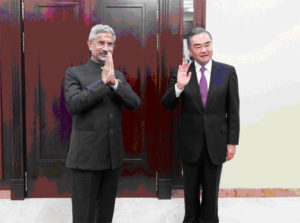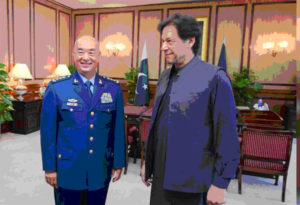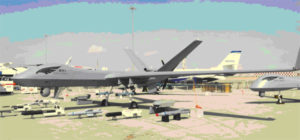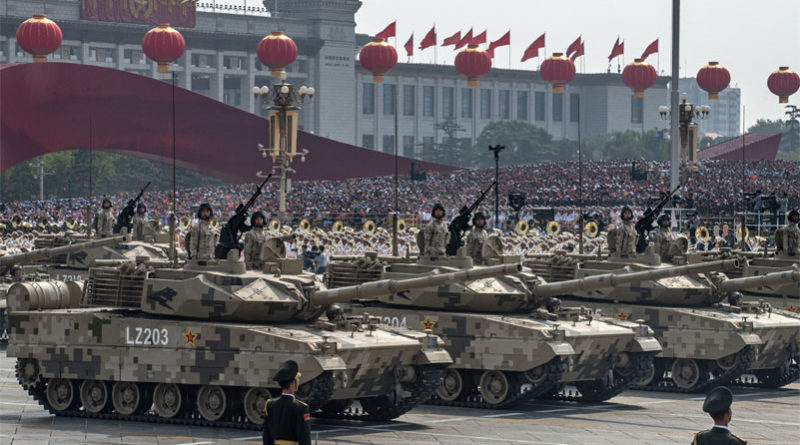The Chinese Military Threat is Not a ‘Border Dispute’, It’s Time India’s Leaders Realised This
By Pravin Sawhney
3 June 2021
Unfamiliar with PLA’s information war, and worried about its excellent border management and military power supporting it, India, in the one year of the Ladakh crisis threw in the towel on three occasions.

Prime Minister Narendra Modi with chief of defence staff General Bipin Rawat (left) and army chief General M.M. Naravane (right) during in his visit to Ladakh in July 2020
The genesis of the Ladakh crisis, which started in May 2020, lies in the creation of the Ladakh Union territory on August 5, 2019 and the release of new maps by India on October 31, 2019. One and a half years on, the situation has deteriorated sharply with India oblivious to the military threat from China and Pakistan. Moreover, the Indian military, trained in the air-land battle concept of the 1980s, is preparing for the wrong war: It has failed to differentiate between China’s informationised conventional war and information war, which is waged during crisis, as a prelude to war and in concert with war.
Air-land battle lays emphasis on gaining initial success by the clarion call of ‘win the first battle’. Placing undue importance on tactics, the air-land doctrine divides the enemy area into a tactical level – for fighting battles and engagements – and operational level for dealing with major operations and campaigns. There is an inflexible relationship between the commander’s mission and military art: Tactics is meant to win battles; operations to win campaigns; and strategy is designed to win wars. This doctrine was designed for a show of force at the beginning of the campaign since it lacked rationality for the three-tier spatial division of the battlefield.
The Indian military follows air-land as the basic framework for war, with an excessive focus on tactics. This has led to three fallouts: Commanders at all levels have become risk-averse and unimaginative; they pay little attention to optimising military art – how to exploit technologies with new concepts of operations; and the operational level simply became a more enhanced version of the tactical level, with quantitative rather than qualitative difference.
India’s Failure To Read Chinese Intentions
Given the 30 year gap in the concept of operations and capabilities between the Indian military and the People’s Liberation Army (PLA), a decisive war of occupation between India and China within five years cannot be ruled out since India continues to misread Chinese intentions and military capabilities.
However, going back to the seeds of the current crisis, within hours of India’s announcement of the Ladakh UT, China rejected the new reality. External affairs minister S. Jaishankar was impelled to travel to Beijing on August 11, 2019 to explain to Chinese state councillor and foreign minister Wang Yi that notwithstanding the new realities of Jammu and Kashmir, and Ladakh, India will not make new sovereignty claims, and its position on the Line of Actual Control (LAC) and the Line of Control (LC) would not change. China refused to accept India’s explanation. It insisted that British-India did not have a border between Tibet and Ladakh. Moreover, India formally accepted the Tibet Autonomous Region as part of China during prime minister Atal Bihari Vajpayee’s visit in 2003. Hence, from Beijing’s perspective, India under Prime Minister Narendra Modi had created a border where none existed.

Chinese State Councilor and Foreign Minister Wang Yi meeting Indian Foreign Minister Subrahmanyam Jaishankar on the sidelines of the Shanghai Cooperation Organisation meeting in Moscow, Russia September 10, 2020.
Recall that in December 2010, China had announced that its border with India was merely 2,000km. This excluded Ladakh. Once India created the Ladakh UT, the PLA, finding an opportune time in May 2020, made multiple deep intrusions in Ladakh and occupied territory up to its 1959 claim line at most places without firing a single shot. With this act, the military threat to Ladakh increased with China and Pakistan joining hands there. Moreover, at the height of the Ladakh crisis, China, in September 2020 said that the entire Indian state of Arunachal Pradesh (some 90,000 square kilometres) called Zangnan (south Tibet) was its territory. Incidentally, Chinese supremo Xi Jinping has on numerous occasions said that China would reclaim all territories bequeathed to it by its forefathers.
Since Tibet is part of China’s core concerns – the others are Taiwan, Xinjiang, and the South China Sea – over which it would fight and not compromise, the military threat to India is not a border dispute, but the PLA’s war of occupation for what it calls south Tibet. Indian military leaders consider the border dispute as the threat and continue to talk about limited war, salami slicing, border war and so on, which it is not. An added threat has been created in Ladakh, which should have been evident to India when on August 27, 2019, China’s vice chairman of the Central Military Commission (CMC) – People’s Liberation Army’s (PLA) highest policy making and planning organisation – Xu Qiliang travelled to Pakistan for a week where he met the entire political and military leadership.
Xu Qiliang And Pakistani Involvement
A slight digression to explain Xu’s stature might be in order. The Biden administration had recently made three unsuccessful requests for interaction between US defence secretary Lloyd Austin and Xu, which China refused, saying the head of the Pentagon was not his appropriate level. It instead suggested Chinese defence minister Wei Fenghe for the meeting. The US knows that Xu carries greater authority (next only to Xi Jinping) on military matters.
It was, therefore, unusual for Xu, a serving third term member of the CMC to go to Pakistan for international military cooperation, which is the job of the Chinese defence minister. Pakistani media reported that Xu’s visit was in line with China’s 2019 international military cooperation plan agreed upon by the two countries. Number two to CMC chairman, Xi Jinping, Xu’s Pakistan visit was meant to assure China’s support strategically, politically, and especially militarily on the common mission (against India). It was no coincidence that in August 2020, Pakistan inaugurated its Centre for Artificial Intelligence and Computing (CAIC) under the Pakistan Air Force (PAF) which had shown a good account of itself during operation Swift Retort on February 27, 2019 against the Indian Air Force.

General Xu Qiliang, vice chairman of Central Military Commission (CMC) China, with Pakistan Prime Minister Imran Khan.
Xu, a former PLA Air Force commander and the man responsible for China’s 2015 military reforms, succeeded in impressing upon Pakistan the significance of making the PAF the lead service in the war. It’s no secret that the Pakistan military is dominated by its army. The PLA was ready to share select virtual war domains capabilities (cyber, electronic warfare, electromagnetic spectrum, outer space) with the PAF for war in north Kashmir, comprising Sub Sector North (the Depsang plain), Daulat Beg Oldie and Siachen, which is Indian military’s operational vulnerability.
Once this was done, the PLA, in one year of the Ladakh stand-off, enhanced real-time situation awareness which it would share with the Pakistan military. It laid fibre optic cables right till the edge in Ladakh, including on Indian territory it had come to occupy. It brought 5G wireless communications in TAR. It has deployed small, smart, and artificial intelligence embedded electro-optical, infra-red, radar, and radio frequency sensors along the LAC. It is using Unmanned Aerial Vehicle (UAVs) for regular Intelligence, Surveillance and Reconnaissance (ISR) missions. Its Yangon satellites constellation is available for round-the-clock surveillance. China’s Beidou global navigation satellite system is available for Position, Navigation, and Timing (PNT) to provide accuracy for missiles.
China successfully sent its civilian Galaxy-1 satellite for 5G connectivity in low earth orbit in 2021; and the entire Galaxy space network with 144 satellites is slated to be completed in three years. It would provide high speed, low latency communication services globally, including in remote areas. This dual-use space network would provide high-resolution intelligence, high-speed communications, and data network to the PLA and PAF round the clock. The PLA also completed a three-dimensional panoramic datum of the entire (20,000km) western theatre command with centimetre level accuracy in 2021. The system has military significance, as it will contribute to the tactical and strategic judgment of commanders and soldiers with better situational awareness and provide geographic data for weapons systems.
Chinese Foresight
With exceptional transparency and communications available in its western theatre command, along the LAC, Indian hinterland, and beyond, the PLA would have two war-winning advantages: One, it would be impossible for the Indian Army and the IAF to hide anything since the PLA would have real-time situation awareness across Jammu and Kashmir into Pakistan. With three war theatres – TAR; Ladakh and Jammu and Kashmir; and Pakistan Occupied Kashmir and Gilgit Baltistan – coming under the PLA’s constant ‘stare’ or satellite watch, the dimension of war threat to India would transform. Instead of a two front-war where the Indian military would fight on one front while maintaining a defensive posture on the other front, it would be a two front reinforced war where both fronts would fight offensively against India in Ladakh and Kashmir.

Chinese Wing II Loong drone, capable of carrying multiple FT( 50kg) guided bombs
The second advantage would be the PLA’s familiarity with the Indian military and its environment. The Indian Army’s deployment patterns which indicate its war concepts on how, where, and with what they would fight attrition war would become evident. The logistics line supporting the war effort would be known and could be destroyed and disrupted by the PLA at will. The Indian Army’s forward ammunition and missiles storage (under and overground) would be marked. The time frame for more accretion of forces would be clear (airlift for Indian troops would not be available). The weapons to be used, their calibration, and training with them would be understood.
Communication means and forward command and control centres would be identified and marked. Where and how many fibre optic cables were laid, and whether Indian troops have 3G or 4G communications (Indian military lacks 5G communications) will be identified. Importantly, the PLA knows that since the Indian military would not be able to make up attrition losses (of platforms and specialised ammunition), it cannot fight with intense rates of fire. And that the Indian military has very little capability in virtual domains of cyber, electromagnetic spectrum, and space.
While the PLA would know everything about the Indian military, the latter does not even understand that the PLA would fight a different war. Unlike the Indian Army and the IAF, which would fight with their manpower and platforms, the PLA would fight with its capabilities across virtual and physical war domains. There is a big difference between platforms like drones, tanks, guns and so on which can be bought off-the-shelf, and cutting-edge capabilities which go into these platforms, as well as capabilities which are used for combat in virtual domains. Few nations would sell these.
An Ensuing Chinese Multidimensional War
Fought with capabilities, PLA’s informationised conventional war is about information dominance by one’s own side and information denial to the enemy to disrupt his forces cognitively. Deep down, the purpose of this war is to weaken the cognitive capabilities or the enemy’s will to fight. Without regular information flow, the enemy’s judgement would be clouded, he would get confused about his environment: What is happening with his neighbourhood formation, where is the enemy, why is he unable to get through to his subordinate units etc.
In this state of confusion, he would not risk war escalation. He would want the war to end, provided casualties on his side are fewer and manageable. The side with first mover advantage, and better environmental understanding about when, where, and how precise attacks should be done on communication systems and command and control centres for information denial would win.
In addition to fighting informationised war with minimal attrition, the other, and equally important operation would be to conduct successful information war or cognitive confrontation. Informationised and information war are different: the former is a military operation by attacks on software networks, communication systems and command and control hubs, the latter is about grey zone operations below the threshold of military confrontation, and in concert with military actions in war.
Grey zone operations done under information war include cyber attacks, espionage, economic war, political warfare, and physical intrusions (Ladakh) within red lines. The PLA, which is the originator of the cognitive confrontation concept gives equal importance to information war, which is the responsibility of the Political Works Department (PWD), and the informationised war done by the tri-service Joint Staff Department (JSD) responsible for conventional and nuclear wars. The head of the PWD is a member of the seven-member Central Military Commission (CMC), and reports directly to the CMC. Political warfare (component of information warfare) is a constituent of another strategic organisation – a strategic support force – which reports directly to the CMC.
Political warfare comprises “three warfare”: Public opinion warfare, psychological warfare, and legal warfare. The public opinion warfare shapes favourable narrative by the use of print, electronic, and social media platforms to influence domestic and international opinion. China considers mobilisation of domestic opinion essential to announce Chinese resolve to the world. For example, in a war, China would seek to project India as the aggressor in the occupation of Chinese territory. The perception would be that China is fighting in self-defence.
The psychological warfare will be directed against foreign policy-makers on how they should approach Chinese policies and its red lines. The legal warfare would build legal justification for Chinese action using domestic laws. In addition to the PLA’s political works department, China would use organs of the state council (Chinese government), ministry of foreign affairs, various intelligence services and so on to build a strong case of ‘enemy aggression’.
Cyber too would play an important role in spreading disinformation in early stages of war. This would be combined with cyber-attacks on select commercial, financial, and military installations as well as on day-to-day activities to disrupt normal civil life. Artificial Intelligence will be used to enhance cyberattacks and information war – to do it with precision and at macro-scale with increased speed. The purpose of cognitive confrontation by information warfare would be to seek early negotiations. This is in sync with Chinese asymmetrical thinking of ‘winning without fighting’.
The PLA does its information warfare regularly against the US military in the case of the South China Sea, when the latter does freedom of navigation patrols. Familiar with PLA’s information warfare, the US military, to avoid an escalation to PLA’s informationised war (what the US military calls joint all domain operations) had sought a meeting with Xu to define mutual red lines on intrusions, which China refused.
Unfamiliar with PLA’s information war, and worried about its excellent border management and military power supporting it, India, in the one year of the Ladakh crisis threw in the towel on three occasions, seeking early negotiations and peace on LAC.
The June 15, 2020 Galwan valley clash where the PLA used primitive weapons like spears, stones, and serrated rods should have informed India that China had no intentions of escalation to war. Yet, the Prime Minister made his infamous statement on June 19 that no one had entered Indian territory. Next, the Indian Army was asked to undo the Kailash range tactical gain made in south Pangong in return for nothing. Finally, Union minister and former army chief V.K. Singh made his shocking statement that the Indian Army does more transgressions than the PLA on the LAC.
It is ironic that after having shamed its own army, accusing it of transgressions instead of praising it for having held the LAC with resoluteness since 1993, defence minister, Rajnath Singh told the nation that the status quo ante to April 2020 would be done. Worse, the chief of army staff, General M.M. Naravane who should have known better, recently expressed hope of mutual disengagement, de-escalation, and de-induction of forces. He also said that the Indian Army was ready for all eventualities (including war).
Here are the two realities that the Modi government and India’s military leadership should be aware of: the Tibet Autonomous Region is the permanent habitat and operational base of China’s western theatre command, whose sole purpose is to fight wars with India and Bhutan. Given this, the PLA threat will continue to grow: the PLA is ready to fight its informationised war now. By the end of 2023, China would be ready with its intelligentised war against the Indian military, which continues to cling to outdated war concepts, legacy equipment and no disruptive capabilities.
The second reality is that the Indian military has confused the PLA’s information war for the informationised war. Ironically, it is the latter that it should prepare for right away.
Pravin Sawhney is the editor of FORCE news magazine.
Courtesy: The Wire

